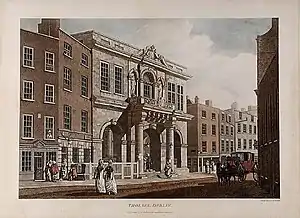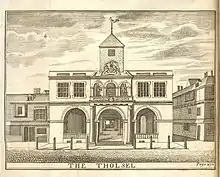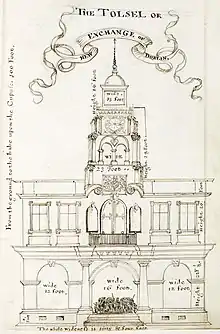The Tholsel, Dublin
The Tholsel, Dublin was an important building which combined the function of civic hall, guildhall, court and gaol which was located on Skinner's Row (now Christchurch Place) in central Dublin, Ireland. It existed in various forms from after the Norman invasion of Ireland until it was finally demolished around 1809. It was one of the most important and imposing buildings in medieval Dublin and was a secular focal point within the city walls situated at a major crossroads close to Dublin Castle, St Patrick's Cathedral and Christchurch Cathedral. It was the first of several tholsels which were constructed in the major cities and towns of late medieval Ireland and the Dublin tholsel also housed the first public clock in Ireland on its tower from 1466.[2][3][4]
| The Tholsel | |
|---|---|
 An illustration of the tholsel in c.1790 by James Malton[1] | |
| Location | Skinner's Row Dublin 2 |
| Height | 27 metres (89 ft) |
| Built | First version in 1200s "New tholsel" 1311 Re-built 1681 |
| Demolished | 1809 |
| Architectural style(s) | Classical |
| Owner | Dublin Corporation |
History
There are mentions of the tholsel as far back as 1311 being called the 'new' tholsel indicating an earlier building had probably been constructed sometime after Henry II had granted Dublin to his men in 1164.
In 1343 the tholsel is again mentioned when there was a charter granted by Edward III which set an exemption from the portion of tolls due to the King so that the burghers of the city could repair the building.
Later in 1395 a Geradus Van Raes was appointed keeper of the Dublin Tholsel for life. He was granted the keep of both the upper and lower gaol in that tholsel indicating an increasing number of prisoners. The upper keep was usually reserved for debtors while the lower keep was for felons and more serious criminals.[5]
In 1590 the archbishop of Dublin Adam Loftus addressed the Lord mayor and corporation of Dublin at the tholsel and requested the use of the old priory at All Hallows to establish a University. He was granted permission and two years later he established Trinity College Dublin on the site. In 1597, the condition of the building, already weakened by a great cleft in the eastern flank, deteriorated under the force of the Dublin gunpowder explosion.[6]
In 1775, in an address to King George III, 3,000 freemen of Dublin, assembled at the tholsel to urge a conciliatory policy towards the American colonists in order to ensure peace between Britain and the American colonists.
The building from 1682 - 1809


The last tholsel building was completed around 1681 and was finally occupied by the corporation and merchants' guild in 1682.[8][9]
In his study of Protestant Dublin in the seventeenth and eighteenth centuries, Robin Usher describes the building as roughly square in plan and abutted on one side by houses. The elevations consisted of an arcaded ground storey, open to the elements on the north and western sides with a fenestrated piano nobile above. The city assembly and the board of alderman met in richly ornamented rooms over the ground floor loggia, itself fitted out as the merchants’ exchange. Two statues sculpted by William De Keysar depicting King Charles II, and his brother, James Duke of York, along with the royal coat of arms were sculpted faced the building to the front.[10]
The tholsel features as one of the most notable of the 25 illustrations in James Malton's A Picturesque and Descriptive View of the City of Dublin and is one of the few structures depicted which does not remain standing as of 2020. The building is shown facing directly on to Skinner's Row at the corner of Nicholas Street near the Church of St.Nicholas Within with an adjacent lane named Ram Alley running alongside as well as the property of Robert Thomas, Tallow Chandler at 1 Skinner's Row. Records indicate that this was historically accurate with the business of Robert Thomas in situ at the adjacent property around the time of Malton's illustration in 1791. The illustration shows the building without a tower, cupola or weather-vane which had all been lost in the previous decades as the building gradually degraded and fell out of functional use.[11]
Its ultimate demise came with the construction of the Royal Exchange and the migration of all major trade and mercantile operations to this more grand and spacious commercial building in the late 18th century. The only portions of the structure which still exist are the royal coat of arms and two front statues which were removed to the crypt of the nearby Christchurch Cathedral prior to demolition where they remain open for public viewing as of 2020.
Various plans for replacements were drawn up with a site at the old Custom House on Essex Quay earmarked for a new design by Benjamin Eaton in 1797 while another design by Richard Johnston in 1805 was proposed for further upriver alongside a new marshalsea.[12][13]
List of Clerks of the Tholsel
References
- "Tholsel, Dublin". The Art Institute of Chicago. Retrieved 11 November 2020.
- "A reminder of Dublin's Tholsel building". Come Here To Me!. 21 September 2013. Retrieved 9 October 2020.
- Frank Hopkins (2003). Rare Old Dublin: Heroes, Hawkers & Hoors. Mercier Press Ltd. pp. 54–. ISBN 978-1-86023-154-4.
- "Dublin's civic buildings transcript". Dublin City Council. 28 October 2014. Retrieved 5 January 2021.
- Sir John Thomas Gilbert (1861). A History of the City of Dublin. J. Duffy.
- "Dublin's Great Explosion of 1597". History Ireland. 2013-01-25. Retrieved 2021-02-07.
- Galway, Moore Institute @ NUI (9 May 2018). "Ireland Illustrated: View a Record". NUI Galway. Retrieved 5 January 2021.
- "1682 – Tholsel, Dublin". Archiseek - Irish Architecture. 9 December 2011. Retrieved 22 October 2020.
- "In Exchange". The Irish Aesthete. 17 May 2014. Retrieved 7 February 2021.
- R. Usher (13 March 2012). Protestant Dublin, 1660-1760: Architecture and Iconography. Springer. ISBN 978-0-230-36216-1.
- Toby Barnard; Bridget McCormack (24 January 2020). Archives of the Tholsell Court, Dublin. Four Courts Press. ISBN 978-0-9505488-7-6.
- "CO. DUBLIN, DUBLIN, THOLSEL & CITY MARSHALSEA (PROPOSED) Dictionary of Irish Architects -". www.dia.ie. Retrieved 22 October 2020.
- "CO. DUBLIN, DUBLIN, THOLSEL &C. (PROPOSED) Dictionary of Irish Architects -". www.dia.ie. Retrieved 22 October 2020.
- John Thomas Gilbert (15 November 2012). Historic and Municipal Documents of Ireland, A.D. 1172-1320: From the Archives of the City of Dublin, Etc. Cambridge University Press. pp. 11–. ISBN 978-1-108-04887-3.
- "Country House Hotel Navan | Navan Hotel | Bellinter House". www.bellinterhouse.com. Retrieved 25 November 2020.
- Francis Elrington Ball (2005). The Judges in Ireland, 1221-1921. The Lawbook Exchange, Ltd. pp. 357–. ISBN 978-1-58477-428-0.
- "The Project Gutenberg eBook of Ireland Under the Stuarts vol. 3, by Richard Bagwell, M.A." www.gutenberg.org. Retrieved 25 November 2020.
- "The Gonne family". www.pastpresented.ukart.com. Retrieved 25 November 2020.